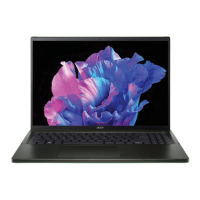Table of contents - 3
TABLE OF CONTENTS
First things first 5
Your guides ............................................. 5
Basic care and tips for using your
computer.................................................. 5
Turning your computer off........................... 5
Taking care of your computer ..................... 6
Taking care of your AC adapter.................. 7
Cleaning and servicing................................ 7
Guidelines for safe battery usage ............... 8
Internal battery....................................... 10
Taking care of your vision...................... 10
Your Acer notebook tour 12
Screen view ...................... 12
Keyboard view ....................................... 13
Left view ................................................ 14
USB Type-C information........................... 14
Right view ............................................. 15
USB Type-A information ........................... 15
Base view .............................................. 16
Using the keyboard 17
Lock keys............................................... 17
Special keys .......................................... 17
Hotkeys.................................................. 19
The Windows OS Desktop 20
Tips and hints for using Windows.......... 21
Where are my apps?................................. 21
Can I turn off notifications? ....................... 21
How do I check for Windows updates?..... 21
Where can I get more information?........... 21
Using the Precision Touchpad 22
Touchpad gestures................................ 22
Changing touchpad settings .................. 24
Recovery 25
Creating a file history backup ................ 25
Backing up your wireless and LAN
drivers.................................................... 28
Restoring your computer ....................... 28
Reset this PC and keep my files............... 28
Reset this PC and remove everything ...... 32
Using a Bluetooth connection 36
Enabling and disabling Bluetooth .......... 36
Enable Bluetooth and add a device .......... 36
Connecting to the Internet 38
Connecting to a wireless network.......... 38
Connecting to a wireless LAN................... 38
OLED Screen 42
How to avoid burn-in on an OLED
screen .................................................... 42
Bluelight Shield 43
Securing your computer 45
Using a computer security lock.............. 45
Using passwords ................................... 45
Entering passwords .................................. 46
Fingerprint Reader 47
How to use the fingerprint reader .......... 47
BIOS utility 51
Boot sequence....................................... 51
Setting passwords ................................. 51
Power management 52
Saving power ......................................... 52
Battery pack 54
Battery characteristics ........................... 54
Charging the battery ................................. 54
Optimizing battery life ............................... 55
Checking the battery level......................... 56
Battery-low warning .................................. 56
Traveling with your computer 57
Disconnecting from the desktop ............ 57
Moving around ....................................... 57
What to bring............................................. 58
Universal Serial Bus (USB) 60
USB Type-C port 61
HDMI 62
Video and audio connectors 63
Connecting a monitor............................. 63
Headphones and microphone................ 63
SD card reader 64
Frequently asked questions 66
Requesting service ................................ 68
Troubleshooting ..................................... 69
Troubleshooting tips.................................. 69
Error messages......................................... 69
Internet and online security 71
First steps on the net ............................. 71
Protecting your computer.......................... 71
Choose an Internet Service Provider........ 71
Network connections................................. 73
Surf the Net!.............................................. 74
Internet security software.......................... 74

